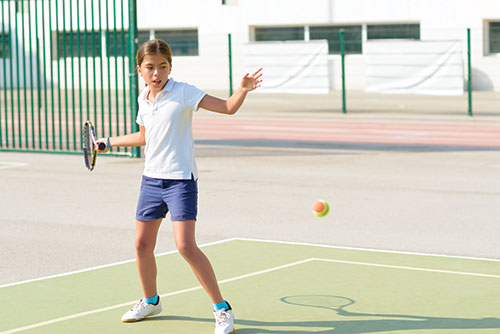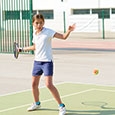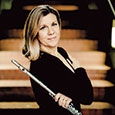
In 2008 I attended a conference on motor learning and music pedagogy. The conference, called Art in Motion at the University of Music and Dramatic Arts in Graz, Austria, was one of the first to bring researchers in sport science and motor learning together with musicians.
The first keynote session was presented by Richard Schmidt on random vs. blocked practice. The theory is simple: athletes achieve better results when randomizing tasks than when blocking them. For example, a tennis player, rather than practicing many forehand strokes in a row, then backhand, then overhand, would use a ball machine so that what comes next is unpredictable. This makes sense because it approximates the skills used during games.
Previously, athletes generally used blocked practice and repeated a skill over and over; (A, A, A, B, B, B, C, C, C) or, serial practice, (A, B, C, A, B, C, A, B, C) alternating between several tasks in a sequence. Then, in 1979, the first study in random practice was done by John Shea and Robyn Morgan. They studied practice and performance when tasks are unpredictable. For example, take the three A’s, three B’s and three C’s from the above examples, toss them in the air and practice them however they land. In a lab during practice, random practice underperformed both blocked and serial practice. However, during a test, those who had utilized random practice methods outperformed people who had used blocked and serial practice, even when the tasks were tested in blocked conditions.
This has interesting ramifications for classical musicians who always perform under blocked circumstances. Musicians always know ahead of time exactly what notes will go where, when and how.
The reasoning behind the success of random practice is simple. It prevents mindless repetition. It is also a way to practice flexibility. The research was convincing, but there are marked differences between music and sports. Sports have clear sets of skills that are easily defined and separated. Music is an art form and requires a subtle mix of planning the overall arc of the notes while allowing for on-the-spot inspiration. I was left with a list of questions.
• How could I randomize practice?
• What elements are there to separate?
• Can I draw a firm dividing line between them? Could I really separate articulation and tone? Or technique and expression?
• Would randomizing tempos be enough to get the benefits? Would that create unnecessary nervousness if I couldn’t perform at a certain tempo?
• Would my technique get sloppy?
• Would practice feel haphazard and unfocused?
.jpg)
I began some experiments and found the most useful application of random practice was to shuffle orchestral excerpts and perform them in the order they land, which is similar to an audition. Practice the unpredictability. Another idea is to randomly play a measure of a piece and notice how different it feels out of context.
I find it helpful to vary tasks and reframe passages with as much variety as I can. I play with a wide variety of emotional expressions, sometimes bordering on the ridiculous, and find that this brings out elements of phrases I have not seen before. Sometimes this expressive playfulness highlights technical issues or gives me a new idea for tone or color. Practice variability, however, is not the same as randomized practice because it does not include the element of unpredictability.
It can feel uncomfortable to use random practice. As the studies showed, people performed worse during random practice, but better in final performance. This is difficult for musicians who have been told not to practice mistakes. However, the idea encouraged me to use more of the most random facet of myself I have – intuition. I allow myself to get a creative impulse and follow it, not only for creative expression, but also knowing there is a predictably better performance in my future.
In 1933, 46 years before the Shea and Morgan study, Alphonse Leduc published 480 Studies of Marcel Moyse. These are technical studies for flute, and they are randomized. The exercises are listed by number in a seemingly random order. They do move up chromatically through each tonal center; however, which pattern will come next is unpredictable. Variety is the order of the book, always asking flutists to practice a new variation on the techniques they already have.
In the preface, he suggests reading horizontally and doing twelve exercises a day. One would move through all twelve tonal centers by doing this. There is not uniformity at the beginning of each row. Row one begins with a scale pattern, row two begins with arpeggiated chords in the third octave, row three begins with ascending minor thirds, continuing through 40 rows without a predictable starting point.
However, another option might be to concentrate around C as a tonal center, for example, and read the chart down instead of across. There are 40 variations centered on C, covering major and minor scales, major and minor chords, blocked and arpeggiated, major, minor, diminished and fully diminished 7th chords, blocked and arpeggiated and intervals of 3rds, 4ths and 5ths. There is never any exercise that is connected to the previous one. To get the brain-wakening benefit of random practice, there is no need to reinvent the wheel. Moyse did it for flutists.
I am now clearer about why I randomize practice and also knowing when to use it. It has become an important part of my teaching as well. There are geniuses in classical music history like Moyse who intuitively knew what science has now validated and explained. This research can serve to refocus both practice and teaching methods and allow art and science to come together to create better performances.






